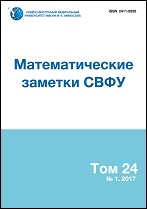|
Mathematical modeling
Numerical methods for identifying the diffusion coefficient in a nonlinear elliptic equation
J. Huangabc, A. V. Grigorevd, D. Kh. Ivanovde
a School of Mathematics and Computational Science, Xiangtan University, Xiangtan, 411105, China
b Hunan Key Laboratory for Computation and Simulation in Science and Engineering, Xiangtan, 411105, China
c Key Laboratory of Intelligent Computing Information Processing of Ministry of Education, Xiangtan, 411105, China
d M. K. Ammosov North-Eastern Federal University, Institute of Mathematics and Informatics, 48 Kulakovsky Street, Yakutsk 677000, Russia
e Yakutsk Branch of the Regional Scientificand Educational Mathematical Center "Far Eastern Center of Mathematical Research", 48 Kulakovsky Street, Yakutsk 677000, Russia
Abstract:
Two different approaches for solving a nonlinear coefficient inverse problem are investigated in this paper. As a classical approach, we use the finite element method to discretize the direct and inverse problems and solve the inverse problem by the conjugate gradient method. Meanwhile, we also apply the neural network approach to recover the coefficient of the inverse problem, which is to map measurements at some fixed points and the unknown coefficient. According to the results of applying the two approaches, our methods are shown to solve the nonlinear coefficient inverse problem efficiently, even with perturbed data.
Keywords:
inverse problem, neural network, nonlinear elliptic equation, optimization, finite element method.
Received: 04.04.2019
Citation:
J. Huang, A. V. Grigorev, D. Kh. Ivanov, “Numerical methods for identifying the diffusion coefficient in a nonlinear elliptic equation”, Mathematical notes of NEFU, 28:1 (2021), 78–92
Linking options:
https://www.mathnet.ru/eng/svfu312 https://www.mathnet.ru/eng/svfu/v28/i1/p78
|

|



 Contact us:
Contact us: Terms of Use
Terms of Use
 Registration to the website
Registration to the website Logotypes
Logotypes